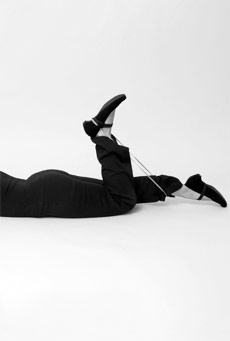|
|
Training with Strength band
 As a complete workout on their own or a
supplement to free weights and machines, strength bands are the ultimate tool
for customizing workouts and isolating
muscles. And the portable bands and
tubing make the perfect travel workout. They're easier on the joints. In
fact, they're so effective and safe that physical therapists often use them with
their patients. As a complete workout on their own or a
supplement to free weights and machines, strength bands are the ultimate tool
for customizing workouts and isolating
muscles. And the portable bands and
tubing make the perfect travel workout. They're easier on the joints. In
fact, they're so effective and safe that physical therapists often use them with
their patients.
For busy moms, it is so simple to carry around these bands in one's car or
purse. A little band exercise can be conducted in the car (perhaps, while
one is sitting in a school parking lot waiting for the kids). It is so simple to
tie the band into a loop and perform quick arm or leg thrusts. Done on a daily
basis for as little as fifteen minutes, one can see serious improvements in
strength,
flexibility, and range of movement.
Perhaps one of the most fantastic benefits of these band exercise is its
simplicity. As it does not require very strenuous activity, the handicapped
or obese can participate and gain the phenomenal
benefits
of a bit of resistance
training. Those suffering from movement-impairing diseases (such as
Multiple
Sclerosis), can increase circulation and movement through strength band exercise.
For people suffering with nerve conditions and other disorders, any kind of
movement can be
painful, let alone exercise.
Band resistance training
empowers the user to be in total control of the level of difficulty. There is no
need to stand or be uncomfortable when using a Theraband, so one can get in
movement without the risk of falling or becoming exhausted.
TheraBands are the only resistive exercise bands endorsed by the American
Physical Therapy Association (APTA). These 6" wide latex bands come in
different, color-coded resistance levels, distinguished by the thickness of the
band:
Band Color
|
Band Thickness
|
Comparison: pounds
of pull needed to stretch a 12" band length to 24"
|
yellow
|
thin
|
2.5 lb
|
red
|
medium
|
4.5 lb
|
green
|
heavy
|
5.0 lb
|
blue
|
extra heavy
|
7.5 lb
|
black
|
special heavy
|
9.0 lb
|
silver
|
super heavy
|
15.0 lb
|
A
thicker band means more
resistance. More resistance means harder work but bigger
muscles. Some users have even doubled up the bands they are using to increase
resistance. Shortening the length of the band you are using also provides more
efficient strength training.
Exercise
guidelines for Band users:
Band workout can improve the cooperation of
muscle groups. It also works on strength and range of motion. The
unique properties of the band allows it to be
stretched and relaxed in a smooth and
consistent manner. This prevents the bounce at the end of a range of motion
exercise that can cause muscle spasms.
When exercising, keep in mind the following:
Do
|
Don't
|
Warm up the
muscle groups before exercising.
|
Don't use
body oil with the band.
|
Maintain
good posture. Keep your wrists straight and in line with your elbows.
|
Don't bend
your wrists. If you start to lose your posture, stop and reposition
yourself.
|
Breathe
normally. Exhale during the most difficult phase and inhale during the
easiest.
|
Don't hold
your breath.
|
Use
controlled movements.
|
Don't
continue exercising if anything hurts while you are training.
|
Maintain
the natural width of the band to keep it from digging into your hands or
sliding up your legs.
|
|
When you
finish your workout, stretch.
|
|
Tip: Make a handle by tying a loop in the
band or tying two bands together.
Use and Care:
Resistance bands are in wide use
throughout the world. They are versatile, portable and
easy-to-use (also inexpensive). However, you should consult your doctor or
health care provider before beginning a resistance program - or any
exercise
program.
While using the band, stay attuned
to your body. If any exercise causes you to hurt - stop!
Don't overdo.
Caring for a
strength band is simple. Just store it out of direct sunlight. Don't use it
together with body oil. And regularly examine it for nicks, tears, or punctures
that might cause the band to snap.
Strength band Workout
Hamstring curl
-
 Tie the band in a knot to make a loop about a foot long. Loop the band
around both ankles. Tie the band in a knot to make a loop about a foot long. Loop the band
around both ankles.
-
Lie face down on the floor with your arms bent at your elbow - palms on
the floor.
-
Turn your head to one side.
-
Slowly bend one knee - bringing your foot up towards your buttocks.
-
Return you foot to the floor.
-
Repeat motion with the other leg.
-
Repeat steps 1-2.
TIP: Avoid arching your back.
Squat
-
Stand on middle of band with both
feet.
-
Grasp ends of band with both hands at waist level.
-
Keep tension on the band as you squat down, bending your knees.
-
Hold & slowly return.
TIP: Keep your back straight. Don't
squat if it causes knee pain.
Shoulder abduction
-
Holding the ends of the band, one in
each hand, step onto the band and place your feet
hip width apart - as if you're standing on a
skipping rope.
-
Knees are slightly bent.
-
Don't arch your back.
-
Raise your arms out from your sides - until they are parallel with your
shoulders.
-
Do not raise your arms above shoulder level.
-
Slowly return your arms to your sides.
-
Check your posture.
-
Repeat steps 1-4.
-
Chest Press
-
Wrap the band around your shoulder blades and bring the ends underneath
your arms.
-
Grasp ends of band at shoulder level.
-
Extend your arms forward, straightening your elbows.
-
Hold & slowly return.
TIP: Avoid arching your back.
Hip Abduction
-
Tie the band in a knot to make a loop about a foot long.
-
Loop the band around your ankles.
-
Keeping both knees straight, extend one leg outward.
-
Hold & slowly return.
-
Repeat on other side.
TIP: Avoid bending your
back.
Reverse Flies
-
 Stand and grasp the middle portion of the band with both hands. Stand and grasp the middle portion of the band with both hands.
-
Keeping your elbows straight, stretch the bands at shoulder level until
you form a "T" with your body.
-
Hold & slowly return.
TIP: Avoid arching your back.
Lateral Raise
-
Stand on the middle of your band.
-
Grasp each end of the band at waist level at your side.
-
Raise arms from your side, keeping your elbows straight.
-
Hold & slowly return.
TIP: Keep your back straight and
abdominals tight. Don't go above
shoulder level if it causes pain.
Note: Perform 3 sets of these exercises. Each set should end when you become
fatigued or reach 2 minutes of exercise. Take 30 seconds rest between sets and
strive for completing 3 sets of 2 minutes each.
Dated 06 April 2013
Related Links
|
|
|
|
|









